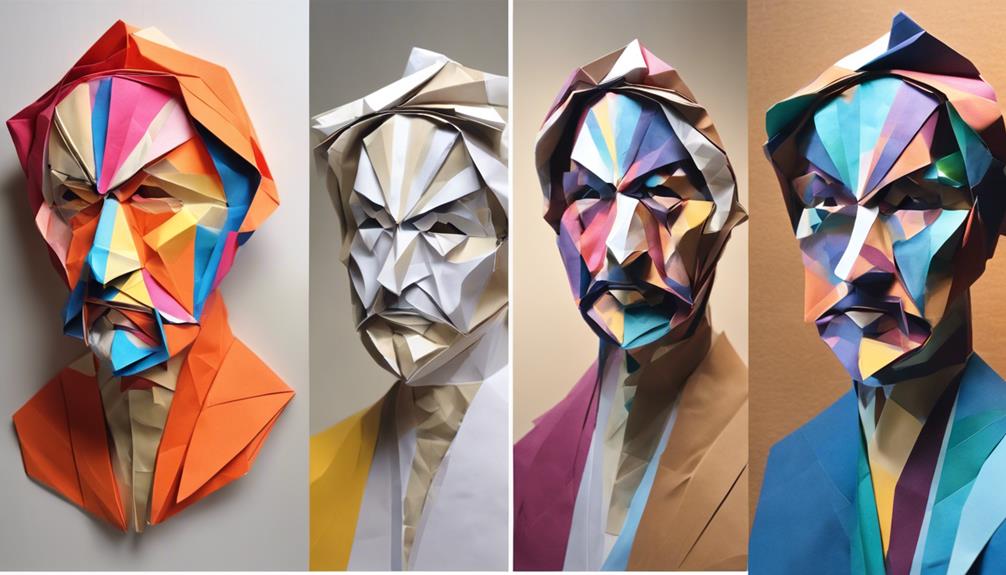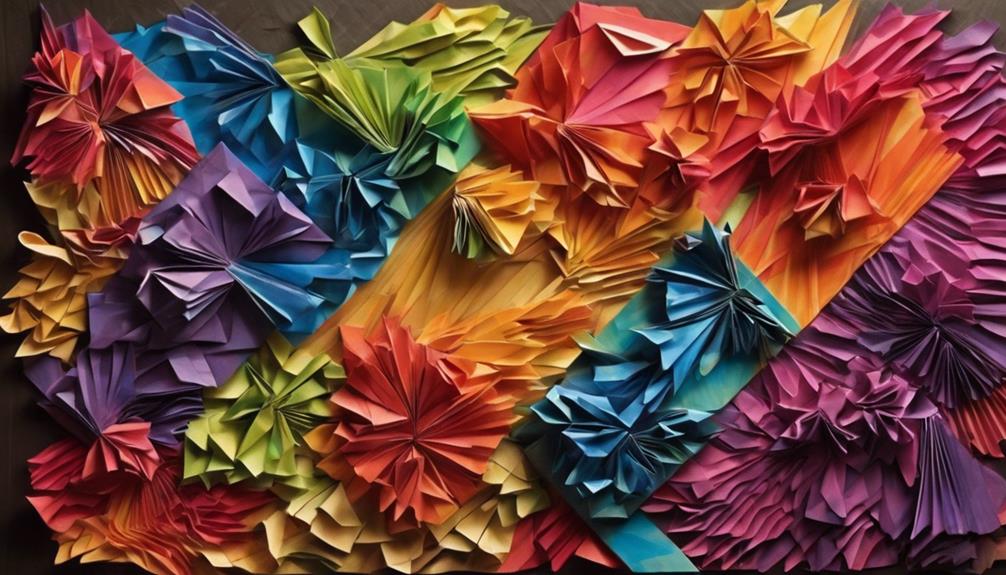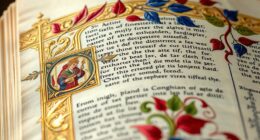Sergi Cardenas has amazed audiences with a dramatic artistic evolution, shifting to captivating dual-image portraits and optical illusions. His innovative techniques, such as vertical relief lines and an icing bag method, set his work apart. Cardenas meticulously crafts facial features, revealing surprising transformations within his portraits. From morphing Marilyn Monroe into Albert Einstein to his unique 3-D effects, Cardenas challenges artistic norms. Recognized in esteemed galleries like Galeria Jordi Barnadas, his creativity knows no bounds. Discover more about Cardenas' mesmerizing artistry and the depths of his groundbreaking style change.
Key Takeaways
- Sergi Cardenas transitions from traditional to innovative art styles.
- Cardenas captivates with mesmerizing dual-image oil portraits.
- Utilizes unique optical illusions and vertical relief lines.
- Astonishes viewers with surprising transformations in his artwork.
- Recognized for his artistic evolution and creativity in prestigious galleries.
Unveiling Sergi Cardenas' Transformation
Revealing Sergi Cardenas' transformation showcases a mesmerizing journey of artistic evolution and innovation. Those exploring Cardenas' work today might find it hard to believe that just a few years ago, his paintings were more traditional. The self-taught artist from Spain has shifted from conventional art to creating stunning optical illusions and dual-image oil portraits that captivate viewers.
Inspired by childhood flip images, Cardenas incorporates vertical relief lines using an icing bag and painters paste, a unique technique that sets his work apart. Before painting, Cardenas meticulously sketches facial features, completing one side of the dual image before revealing the surprising metamorphosis. His ability to morph iconic figures like Marilyn Monroe into Albert Einstein showcases his exceptional talent and creativity.
Displayed at renowned galleries like Galeria Jordi Barnadas in Barcelona, Cardenas' work continues to receive praise for its innovative style and mesmerizing effects. This evolution in his artistic approach highlights Cardenas' dedication to pushing boundaries and challenging traditional artistic norms.
The Mesmerizing Dual-Image Portraits
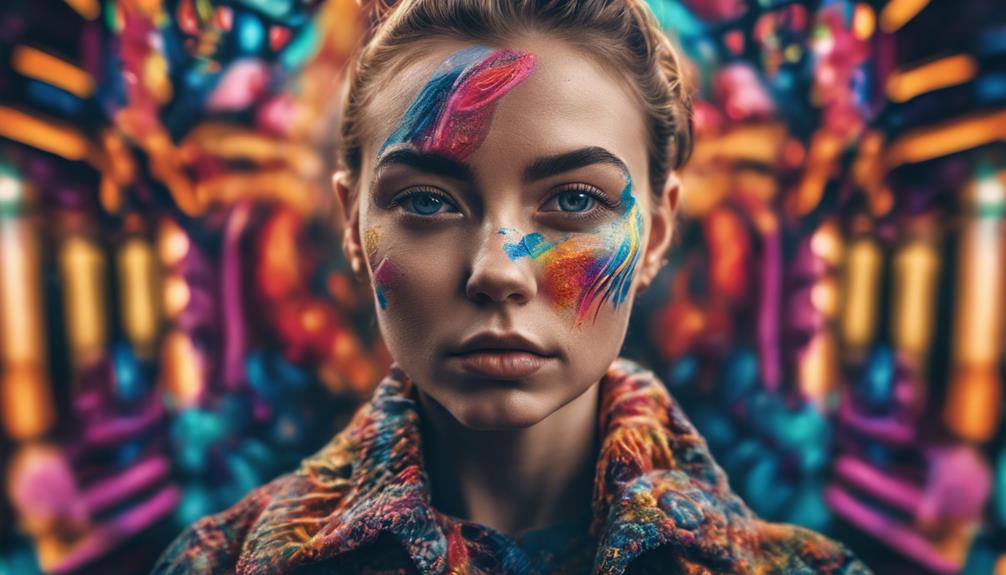
Sergi Cardenas' dual-image portraits showcase a unique technique that enchant viewers with mesmerizing visual illusions. Through his artistic transformation using duality, Cardenas ingeniously combines faces like Marilyn Monroe and Albert Einstein into a single portrait, challenging perceptions and sparking intrigue.
His method involves intricate sketching of facial features, followed by a reveal of the surprise transformation, highlighting his innovative approach to portraiture.
Unique Dual-Image Technique
Utilizing vertical relief lines in his oil paintings, Cardenas captivates viewers with his mesmerizing dual-image portraits. This unique technique allows Cardenas to create paintings that seemingly transform before the viewer's eyes, adding an element of surprise and fascination to his artwork.
The process involves intricate steps that contribute to the magic of the final piece:
- Vertical Relief Lines: Cardenas strategically incorporates vertical relief lines to create a dual-image effect, enhancing the transformative nature of his portraits.
- Inspiration from Childhood: The artist draws inspiration from childhood flip images that reveal hidden designs when tilted, infusing nostalgia and creativity into his work.
- Sketched Facial Features: Using an icing bag with painters paste, Cardenas sketches facial features before painting, setting the stage for the surprising dual-image reveal.
- Sequential Painting Process: Cardenas completes one side of the dual-image portrait before painting the other, showcasing his meticulous approach and adding depth to the transformative process.
Captivating Visual Illusions
Cardenas' dual-image portraits intrigue viewers with mesmerizing visual illusions that seamlessly alter iconic figures and faces within his paintings. By utilizing a unique technique involving vertical relief lines, Cardenas skillfully shifts the perception of his subjects, creating a captivating optical experience for those interacting with his art.
Drawing inspiration from childhood flip images, the artist astonishes onlookers with the smooth transformations between contrasting personalities encapsulated within his dual-image portraits.
One fascinating aspect of Cardenas' process is his method of completing one side of the portrait before the other, heightening the element of surprise and fascination in his artwork. This intentional approach adds depth to the visual illusions present in his paintings, inviting viewers to explore and appreciate the intricacies of his creative vision.
Through his ability to transform well-known figures like Marilyn Monroe into Albert Einstein, Cardenas showcases his innovative spirit and artistic prowess, enchanting audiences with his mesmerizing dual-image portraits.
Artistic Transformation Through Duality
Crafting mesmerizing dual-image portraits through a blend of oil painting techniques and vertical relief lines, Sergi Cardenas captivates viewers with seamless transformations of iconic faces. Inspired by childhood flip images, Cardenas infuses surprise and magic into his paintings, creating optical illusions that shift between different famous figures.
To achieve these stunning effects, the artist follows a meticulous process where he sketches facial features and then adds vertical 3-D lines, completing one side of the portrait before the other. Cardenas' innovative approach to dual-image paintings has garnered recognition in both private collections and galleries, showcasing his exceptional talent and creativity.
Through his unique artistic transformation through duality, Cardenas continues to push boundaries and challenge perceptions of portraiture, leaving audiences in awe of the captivating illusions he brings to life on canvas.
- Sergi Cardenas blends oil painting techniques and vertical relief lines to create dual-image portraits.
- His portraits feature seamless transformations of iconic faces, inspired by childhood flip images.
- Cardenas sketches facial features and adds vertical 3-D lines, completing one side of the portrait before the other.
- Recognition in private collections and galleries highlights Cardenas' talent and creativity in the realm of dual-image paintings.
Optical Illusions in Cardenas' Artwork

Sergi Cardenas' artwork intricately weaves visual trickery and plays with perception through mind-bending optical illusions. His use of vertical relief lines in dual-image oil paintings creates surprising effects that captivate viewers.
Inspired by childhood flip images, Cardenas' portraits, like Marilyn Monroe morphing into Albert Einstein, showcase his unique talent for creating mesmerizing optical art.
Cardenas' Visual Trickery
- Inspiration from Childhood Flip Images:
Cardenas draws inspiration from childhood flip images to create surprising and magical effects in his artwork.
- Utilization of Vertical Relief Lines:
The self-taught artist employs vertical relief lines to craft his unique pieces, enhancing the transformative aspect of his portraits.
- Sequential Painting Process:
Cardenas follows a methodical creation process by sketching facial features before painting, focusing on completing one side before the other. This sequential approach contributes to the illusion of transformation within his artworks.
- Exhibition and Recognition:
His paintings, celebrated for their optical illusions, have been showcased at Galeria Jordi Barnadas in Barcelona, where they've received acclaim for his creativity and innovative use of visual trickery in art.
Artistic Play With Perception
In his artwork, Sergi Cardenas skillfully manipulates visual elements to create mesmerizing optical illusions that challenge viewers' perceptions. Through his dual-image oil paintings, Cardenas transforms faces in surprising and intriguing ways, drawing inspiration from childhood flip images to craft his unique artworks.
A key technique employed by Cardenas is the use of vertical relief lines, which create a 3-D effect in his portraits, revealing different faces as viewers shift their perspective. The surprise effect and magic present in Cardenas' paintings captivate audiences, showcasing his innovative approach to optical illusions in art.
Mind-Bending Optical Art
Cardenas' mind-bending optical art mesmerizes viewers with its transformative and enchanting illusions, particularly evident in his dual-image oil paintings. The intricate details and strategic use of vertical relief lines in his portraits create surprising transformations, captivating audiences with each glance.
Drawing inspiration from childhood flip images, Cardenas skillfully sketches facial features before applying layers of paint, adding depth and dimension to his dual-image masterpieces. The self-taught artist from Spain has honed his craft to perfection, infusing each artwork with a sense of wonder and magic that leaves viewers enchanted.
The innovative approach and meticulous attention to detail in Cardenas' paintings not only showcase his artistic prowess but also demonstrate his ability to push the boundaries of perception, making his work truly exceptional.
From Marilyn Monroe to Albert Einstein
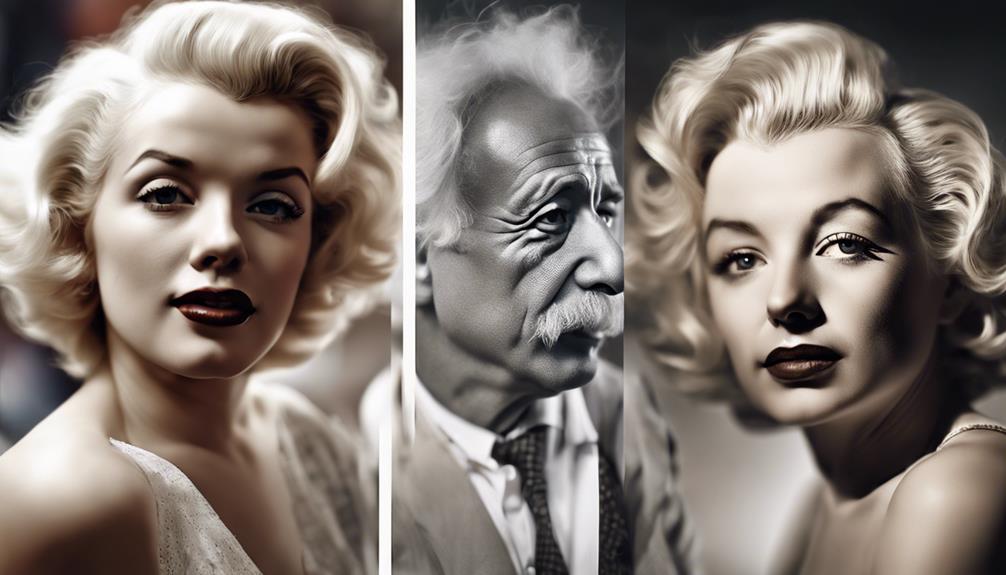
Sergi Cardenas adeptly shifts from Marilyn Monroe's iconic image to Albert Einstein's likeness through his unique dual-image oil painting technique. By skillfully blending the features of these two vastly different figures, Cardenas creates a mesmerizing transformation that astonishes viewers. His ability to smoothly switch from the glamorous Hollywood star to the renowned physicist showcases his artistic prowess and attention to detail.
The surprise element and illusionary magic in Cardenas' paintings captivate audiences, drawing them into the intricate process of the image metamorphosis. Through his innovative use of vertical relief lines, Cardenas masterfully manipulates light and shadow to craft optical illusions that alter the perception of the artwork depending on the observer's viewpoint.
Recognized for his self-taught talent and creative vision, Cardenas has earned a place in prestigious private collections and galleries. Displayed at Galeria Jordi Barnadas in Barcelona, his portraits exemplify his distinctive style and ability to turn familiar faces into unexpected and thought-provoking transformations.
Cardenas' Innovative Artistic Technique
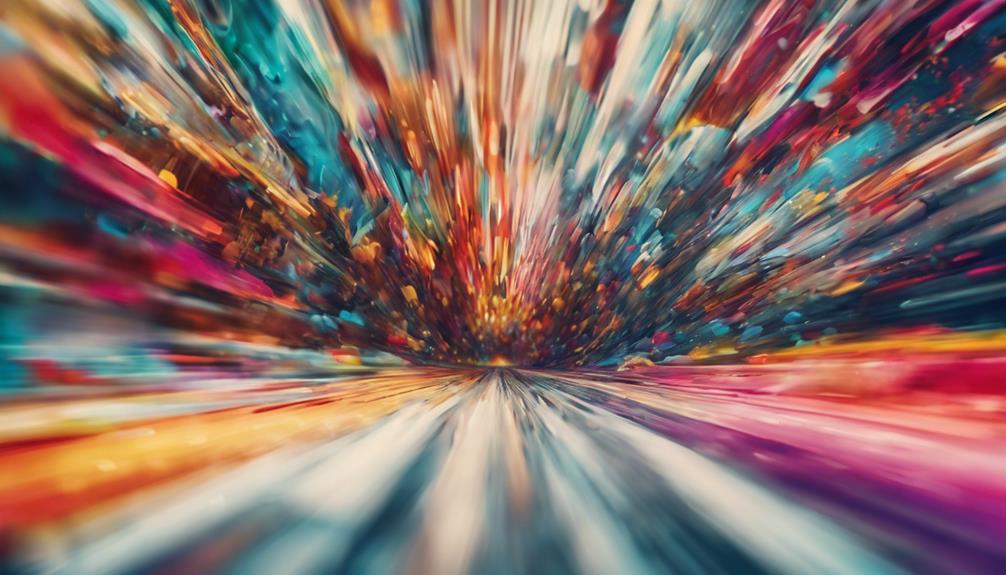
Utilizing an icing bag with painters paste, Sergi Cardenas adds a unique 3-D effect to his portraits through vertical relief lines. Before starting a painting, Cardenas meticulously sketches the facial features of his subjects, strategically planning the transformation and illusion present in his dual-image artworks.
To enhance the element of surprise in his pieces, the artist makes certain that one side of the painting is fully completed before proceeding to the other side. This intentional approach allows Cardenas to fully realize the magic and impact of the transforming faces in his portraits, mesmerizing viewers with his innovative technique.
Through his skillful incorporation of vertical relief lines and meticulous attention to detail, Sergi Cardenas has gained recognition and admiration within private collections and galleries, showcasing his talent and unique artistic vision through visually striking transformations of iconic figures like Marilyn Monroe and Albert Einstein.
The Magic of Vertical Relief Lines

With an icing bag and painters paste, vertical relief lines are skillfully crafted by Sergi Cardenas to create mesmerizing optical illusions in his portraits.
Drawing inspiration from childhood flip images, Cardenas infuses surprise effects and a touch of magic into his paintings.
As a self-taught artist from Spain, he utilizes this unique technique to transform faces into dual images, adding depth and dimension to his artwork.
By sketching facial features first and then applying vertical 3-D lines using the icing bag with painters paste, Cardenas meticulously reveals one side of the dual-image painting before uncovering the other, enchanting viewers with the intricate interplay between the two perspectives.
This innovative approach has garnered Cardenas recognition in private collections and galleries, such as the esteemed Galeria Jordi Barnadas in Barcelona, showcasing the artist's talent and creativity in the world of contemporary art.
Recognition in the Art World

- Sergi Cardenas' unique artistic style has gained recognition for its innovative use of dual images and transforming faces in oil paintings.
- His paintings have been prominently featured in private collections and galleries, including Galeria Jordi Barnadas in Barcelona.
- Cardenas' talent as a self-taught artist has been celebrated for his surprising magic and optical illusions in portraits.
- One of his notable works involves transforming Marilyn Monroe's image into Albert Einstein, displaying his creativity and imagination.
Frequently Asked Questions
Why Is the Beautiful Things Song so Popular?
The song 'Beautiful Things' by Michael Gungor has gained immense popularity due to its poignant lyrics and ability to connect emotionally with listeners. Its message of discovering beauty amidst adversity strikes a chord with many, resonating with those seeking hope and inspiration.
The song's versatility is evidenced by numerous covers across various genres, while its visually enchanting music video further enhances its theme of transformation and renewal.
Why Are Artists Scared of Ai?
Artists fear AI for its potential to devalue handcrafted art, blur authenticity, and displace human creativity. Concerns arise from AI's efficiency, threatening emotional connections viewers have with handmade art.
The uncertainty surrounding AI's impact sparks debates about its role in shaping artistic expression. As the saying goes, 'The devil is in the details,' and AI's rise in art creation raises valid concerns about the future of artistic craftsmanship and the art market's dynamics.
Is Hi Ren a Masterpiece of Music?
Hi Ren's music can be considered a masterpiece by many due to his bold and experimental style change that has captivated audiences. His willingness to take creative risks and push boundaries in his music reflects artistic growth and innovation.
The discussions and debates sparked within the music industry further underline the impact of Hi Ren's work. Overall, his music showcases a unique blend of talent, creativity, and evolution that resonates with listeners.
What Were the AI Images in Late Night With the Devil?
The AI images in Late Night With the Devil were computer-generated visuals resulting from feeding the show's scripts into an AI algorithm. These images portrayed a demon-like figure with glowing eyes and a sinister smile, enhancing the show's eerie and mysterious ambiance.
The integration of AI technology in crafting these visuals showcased the fusion of art and technology in entertainment, captivating viewers with their unique and unsettling visual allure.
Conclusion
Sergi Cardenas' artistic evolution is a whirlwind of transformation, leaving viewers in awe of his innovative style. Like a phoenix rising from the ashes, Cardenas' artwork has undergone a stunning metamorphosis, enchanting audiences with his mesmerizing dual-image portraits and mind-bending optical illusions.
His use of vertical relief lines adds a touch of magic to his creations, earning him well-deserved recognition in the art world. Cardenas' artistic journey is truly a sight to behold.
